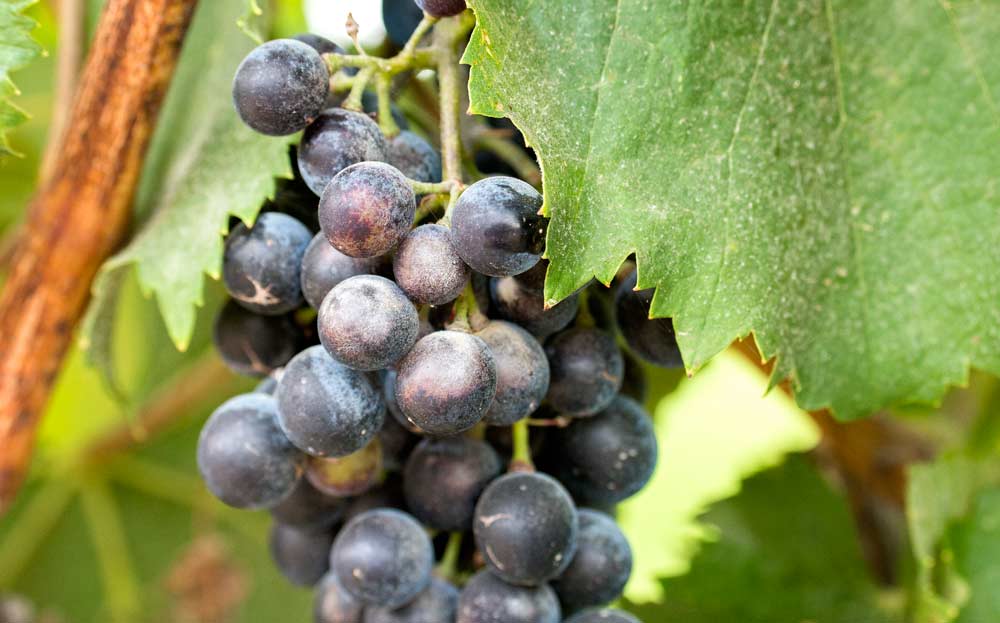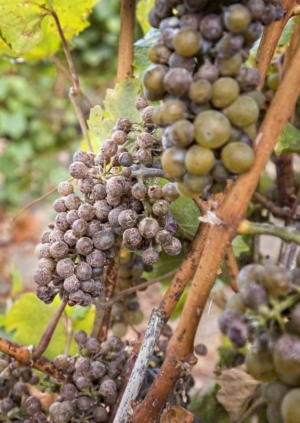
Powdery mildew in Cabernet Sauvignon grapes in Pasco area, Washington, on September 7, 2017. (TJ Mullinax/Good Fruit Grower)
Powdery mildew populations in Washington are becoming increasingly resistant to a common group of fungicides, according to a recent survey, but that resistance is not solely to blame for the many mildew-laden orchards last year.
The 2017 season, weatherwise, was “perfect for mildew,” said Washington State University Extension viticulturist Michelle Moyer, for a number of reasons. Lots of winter and spring precipitation, along with cold damage to primary buds that spurred secondary and tertiary shoots, led to very large, dense canopies. That meant lots of shoots that grew rapidly, and spray programs didn’t always manage to keep up, she said.
Then, during August, when hot sunny days typically put an end to mildew susceptibility, a month of wildfire smoke masked sunshine and raised humidity, prolonging at-risk conditions. By then, it was also too late for some growers who didn’t start spraying early enough, stretched spray intervals too far or sprayed too little to get good coverage on a full canopy, she explained at the Washington State Grape Society’s annual meeting in November.
“We know we’re supposed to spray at 6 inches, but it was really 12 by the time people sprayed because the vines developed so quickly,” Moyer said. “Fifteen to 21-day spray intervals don’t cut it, especially when using oil and sulfur. Oil only lasts for about one day, so that’s having your vines completely unprotected for 20 days. Sulfur, you get five- or six-days protection. It’s great to kick off the season, not good for long-term protection.”
One group of fungicides that used to be reliable now appears to be losing effectiveness across Washington vineyards: 95 percent of vineyards tested in a recent survey showed mildew developing resistance to strobilurins, also known as the Frac 11 fungicide group or Quinone outside Inhibitors (QoI) products.

Powdery mildew in Chardonnay grapes in the Columbia Basin, Washington, on September 18, 2017. (TJ Mullinax/Good Fruit Grower)
However, the increasing resistance found in Washington, Oregon and California may be more a result of recent challenging mildew seasons than the cause, said Walt Mahaffee, U.S. Department of Agriculture pathologist based in Oregon.
“It’s easier to write it off saying resistance is the problem, but I think a lot of the reason we have resistance here is that if these management practices aren’t keeping the disease level low, you have a greater likelihood of getting that (resistance) mutation,” Mahaffee said.
That’s because resistance is a numbers game. The more mildew colonies you have, the higher the odds one or two will develop resistance, survive your sprays, and spread. Also, the more you or your neighbors spray a specific chemistry, the greater the risk.
Of course, resistance is not a new problem. In New York, where growers need a much more intensive spray program and spray more often, resistance to Frac 11 fungicides developed in just two years. In Eastern Washington, where growers may use a product just a few times a year, it has taken much longer for the pathogen to build resistance.
In Oregon’s Willamette Valley, where mildew is a constant concern, resistance has recently been confirmed for Frac group 11 and Frac group 3, the DMIs, while group 7 appears at-risk, said Jay Pscheidt, extension pathologist for Oregon State University.
The current challenge in the Willamette: plan a spray program that alternates sufficiently with the different products that remain effective, he said. Strobilurins should only be used when mixed with something else, if at all, and other at-risk products should only be used once a season.
“The goal is to keep the fungus guessing what you are coming at it with next,” Pscheidt said.
Bloom is an especially critical period for mildew control, he said. If you’ve just sprayed sulfur before the caps fall off the blooms, then all the protective product ends up on the vineyard floor, leaving the ovaries “fantastically susceptible for a few weeks,” Pscheidt said. “As you move into bloom, you need to adjust your spray schedule. If you spray once with a two-week material, you can totally lose your crop.”
He also cautioned growers to look out for suckers that might not be in the spray zone and to keep tabs on decorative vines or susceptible ornamental plants near a tasting room that can be a source of mildew. Two abnormally early growing seasons in 2015 and 2016, when mildew got ahead of a lot of growers, resulted in higher pressure across both Western and Eastern Oregon.
“We’ve run into these years where it caught people off guard, and now we have to be a little more vigilant about going after it,” he said, especially in arid Eastern Oregon where powdery mildew pressure was historically low. “As we have more inoculum and more trouble, powdery mildew will exploit those holes.”
Rough year ahead?
That’s what Washington growers could face this season, as last year left lots of inoculum in the environment. Combined with growing resistance to Frac 11 products, it means there’s little room for error — such as stretching spray intervals or failing to calibrate for canopy size — in a good management plan.
Moyer recommended not using at-risk fungicides at the end of the growing season. “There’s a lot of mildew in vineyards late in the season, so you have a higher risk of selecting for those resistant individuals,” she said. If growers have Frac 11 products, she recommended using them early in the season.
In contrast, Mahaffee cautioned that using an at-risk product early could select for more resistance as the season goes on. “You should always have multiple modes of action in your spray tank,” he said, such as using a Frac 11 product with sulfur, which has never shown resistance. “It just reduces the possibility of resistance development.”
The question now that Frac 11 resistance has been found in Western vineyards in mildew surveys — which focus on acreage with mildew trouble and are not a random sample — is how much resistance does it take to make the product ineffective? There can be a small part of the mildew population that has resistance, but the product will still maintain field control; researchers aren’t clear what that sweet spot is, Mahaffee said. He’s working with Moyer and researchers and extension agents from California to address this question.
“Currently, growers use a product until it doesn’t work, but that’s an expensive way of doing things since you could lose your fruit,” he said.
Surveys from the past few years in Oregon show that when some growers stopped using the product for a year or two, resistance faded, Mahaffee said. Based on that data, he said he’s hopeful the Frac 11 chemistries could be rejuvenated and become effective again at the field scale.
Moyer encouraged growers who want to learn more about the risks of resistance in their vineyards to take advantage of her sampling kits and become part of the research project.
“With the emergence of resistance, I think folks are taking a hard look at their programs,” Pscheidt said. “I’m very optimistic that growers, despite the resistance problems, can get a handle on powdery mildew and continue to grow a great grape crop.” •
—by Kate Prengaman






Leave A Comment